iPhone Imaging: ISS, Crescent Moon;
DSLR Imaging: RW Tauri Eclipse
Posted: 30 January 2017
|
Open: Sunday, 29 January 2017, 1730 MST Temperature: 68°F |
Session: 1066 Conditions: Clear, breezy |
Equipment Used:
12" f/8 LX600 w/StarLock
Wired AutoStar II handset
2" 24mm UWA eyepiece
2" 50mm eyepiece
Focal Reducer
Camera:
iPhone 6s Plus
D7200 DSLR
1740 MST: moved the dome onto the POD Zenith Table (PZT) for this night's pass of the International Space Station (ISS) and for imaging the eclipse of the variable eclipsing star RW Tauri.
Next, began preparing to image the pass of the ISS. I wanted to photograph the Space Station and the telescope. I did several test exposures with the iPhone 6s Plus in various locations inside the observatory. I used my GorillaPod to hold the iPhone. The sky would still be bright during the pass so I didn't know how well the image would turn out. 1754 MST: was now ready for the pass, which would begin at 1809 MST.
As the sky got a little darker the planet Venus and the thin crescent Moon became visible, giving some hope that I would capture the ISS. 1805 MST: the wind was calm now.
Here is the ISS, Venus, the Moon, and the 12" LX600 telescope captured with the iPhone 6s Plus with a clip-on Wide Angle lens using the iOS app NightCap Pro with its "ISS Mode":
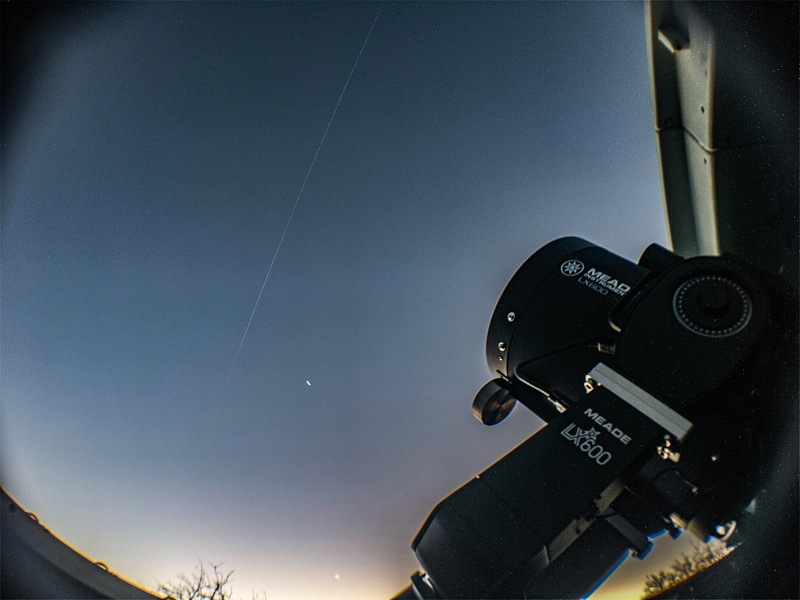
1820 MST: LX600 ON, StarLock OFF, High Precision OFF.
Viewed the crescent Moon, 102X. Then switched to a 2" 50mm eyepiece (49X) and viewed the Moon. That was a nice view with Earthshine very visible.
While waiting the sky to get darker I prepared the D7200 DSLR for imaging RW Tauri.
1841 MST: took this photo of the western sky showing Venus and the crescent Moon with Earthshine, iPhone 6s Plus, NightCap Pro:
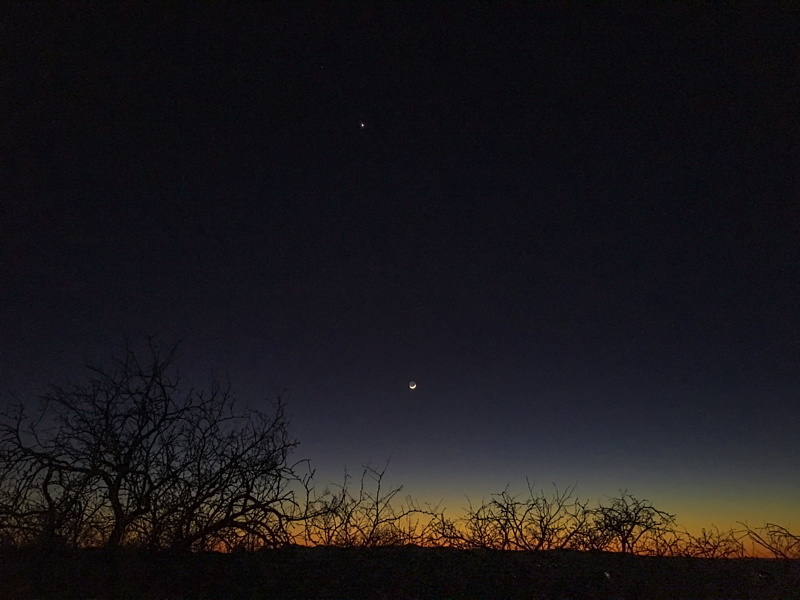
1847 MST: did some iPhone afocal 49X imaging of the Moon and Earthshine using NightCap Pro. This one really shows the surface of the Moon illuminated by sunlight reflected from the Earth:
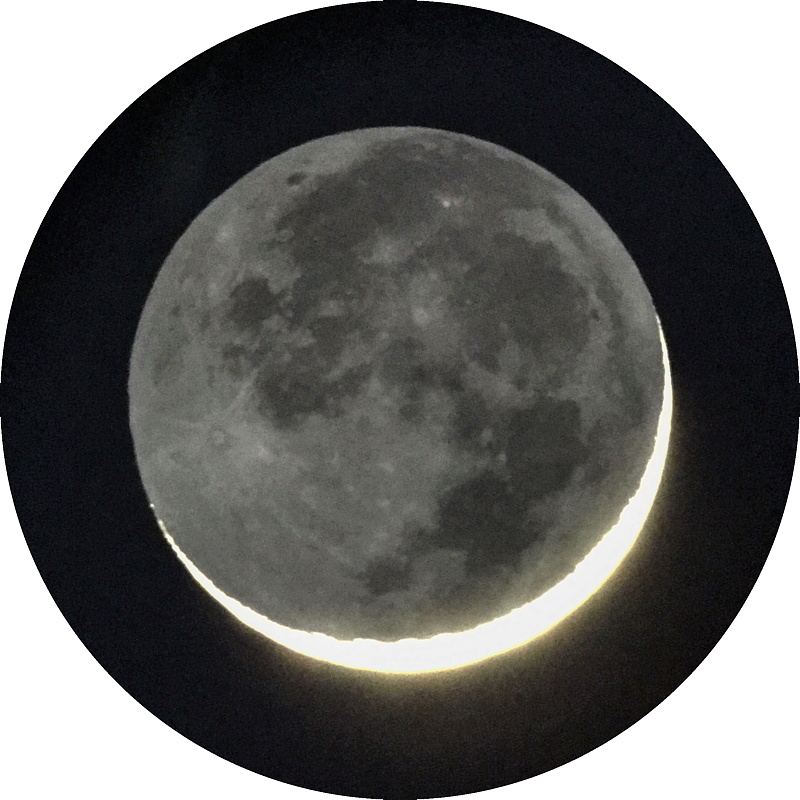
1858 MST: last look at the Moon, 49X, as it was getting too low in the sky for good viewing. Then viewed Venus, 102X. Venus was also showing a crescent phase, but one that was wider than this night's Moon.
1907 MST: slewed the 12" telescope to the star Aldebaran and SYNCed the AutoStar. Then slewed to RW Tauri, confirmed its location in the star field, and SYNCed on it. The star was currently Magnitude +8.0 but would fade to Magnitude +11.5 at mid-eclipse (2310 MST). Slewed back to Aldebaran, mounted the D7200 DSLR at prime focus + focal reducer, focused using the Bahtinov Mask, and locked the primary mirror. 1931 MST: slewed to RW Tauri. StarLock ON (for autoguiding). Did a test exposure of the star field to be certain I could identify RW Tauri in the image; I could. DSLR OFF, but left the StarLock ON.
1941 MST: saw a nice bright meteor pass through the constellation of Pegasus.
SYNCed the observatory clock to WWV. I did 1 minute, ISO 1600, White Balance 4000K, exposures of RW Tauri at 2040, 2110, 2140, 2210, 2240, and 2310 MST. With exposures every 30 minutes I hoped to capture the fading of RW Tauri from Mag +8.0 to Mag +11.5. In-between the exposures I rested on the observatory floor. In the past when there was the 8" and then 12" telescope tripod in the observatory, sitting on the floor was difficult due to the tripods legs. But now with the pier instead of a tripod there is a lot of floor space to rest.
Here is the image of RW Tauri (arrowed) taken at 2040 MST:
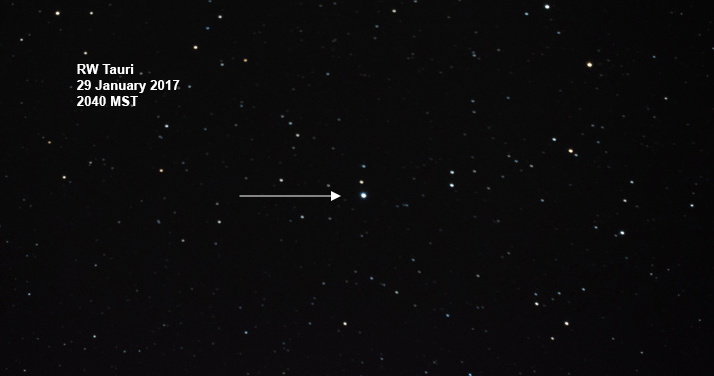
This is an animated GIF showing the fading of RW Tauri as it was eclipsed by its companion star:
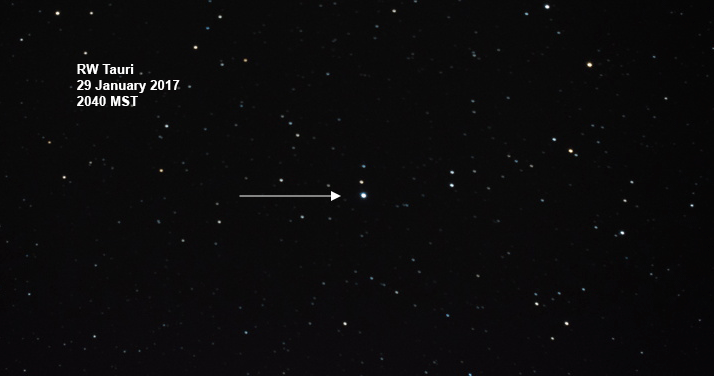
2311 MST: ended imaging. StarLock OFF.
2318 MST: viewed RW Tauri, 102X. It was definitely fainter than it had been when first observed earlier in the night, giving me confidence that I had indeed captured the eclipse.
2319 MST: LX600 OFF. 2331 MST: moved the dome off of the PZT and back onto the observatory wall.
|
Close: Sunday, 29 January 2017, 2338 MST Temperature: 46°F |
Session Length: 6h 08m Conditions: Clear |
Comments are welcome using Email. Twitter users can use the button below to tweet this report to your followers. Thanks.
Cassiopeia Observatory Home Page
Copyright ©2017 Michael L. Weasner / mweasner@me.com
URL = http://www.weasner.com/co/Reports/2017/01/30/index.html
